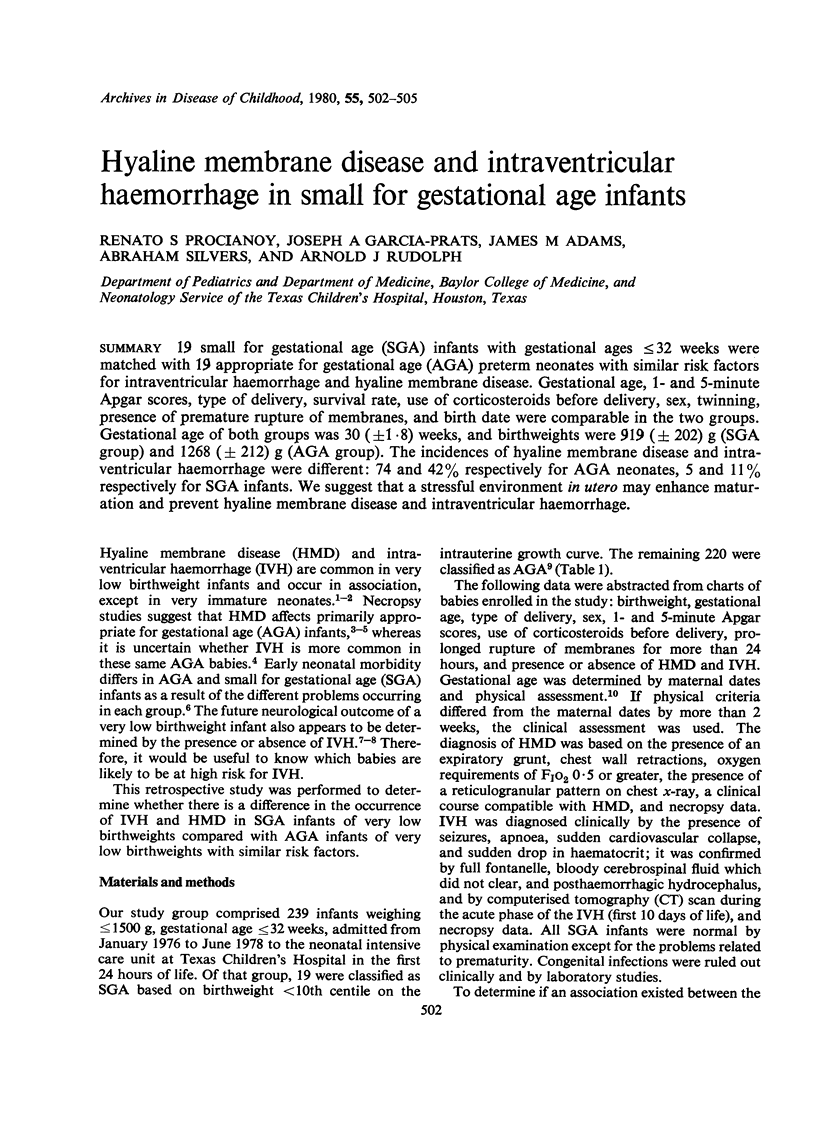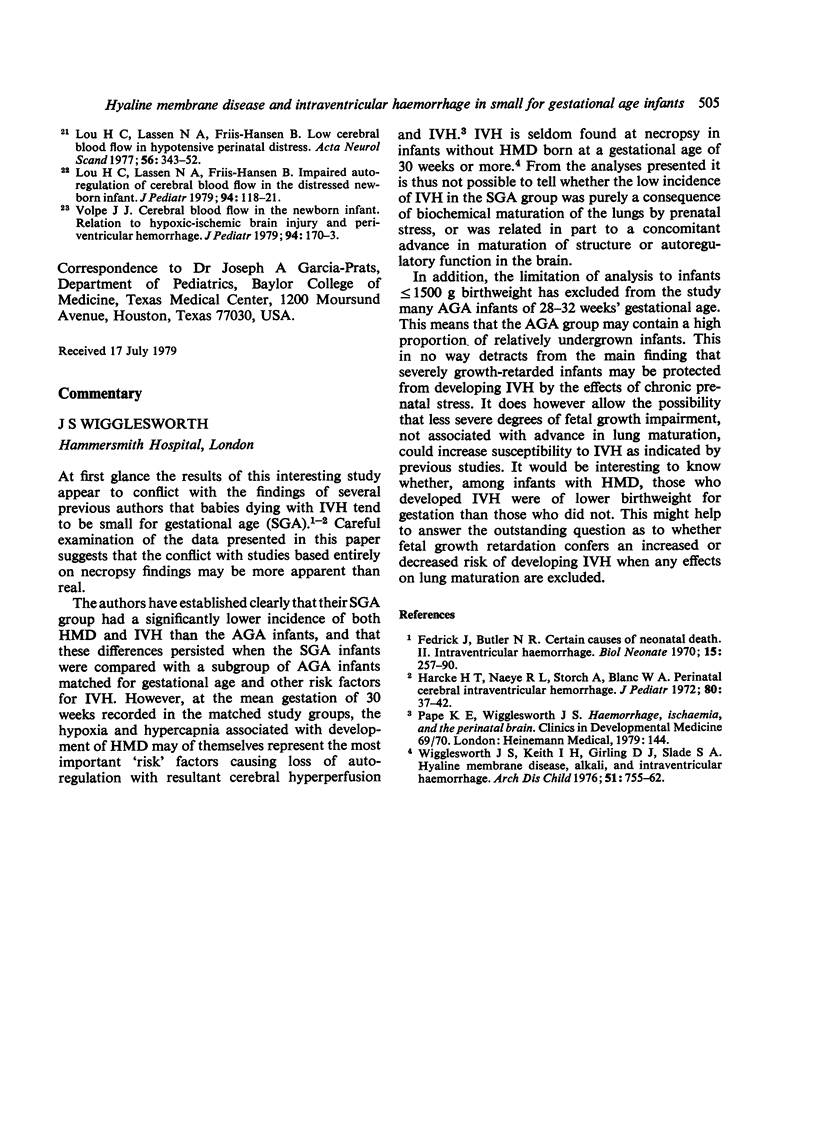Abstract
19 small for gestational age (SGA) infants with gestational ages less than or equal to 32 weeks were matched with 19 appropriate for gestational age (AGA) preterm neonates with similar risk factors for intraventricular haemorrhage and hyaline membrane disease. Gestational age, 1- and 5-minute Apgar scores, type of delivery, survival rate, use of corticosteroids before delivery, sex, twinning, presence of premature rupture of membranes, and birth date were comparable in the two groups. Gestational age of both groups was 30 (+/- 1.8) weeks, and birthweights were 919 (+/- 202) g (SGA group) and 1268 (+/- 212) g (AGA group). The incidences of hyaline membrane disease and intraventricular haemorrhage were different: 74 and 42% respectively for AGA neonates, 5 and 11% respectively for SGA infants. We suggest that a stressful environment in utero may enhance maturation and prevent hyaline membrane disease and intraventricular haemorrhage.
Full text
PDF



Selected References
These references are in PubMed. This may not be the complete list of references from this article.
- Battaglia F. C., Lubchenco L. O. A practical classification of newborn infants by weight and gestational age. J Pediatr. 1967 Aug;71(2):159–163. doi: 10.1016/s0022-3476(67)80066-0. [DOI] [PubMed] [Google Scholar]
- Dubowitz L. M., Dubowitz V., Goldberg C. Clinical assessment of gestational age in the newborn infant. J Pediatr. 1970 Jul;77(1):1–10. doi: 10.1016/s0022-3476(70)80038-5. [DOI] [PubMed] [Google Scholar]
- Farrell P. M., Avery M. E. Hyaline membrane disease. Am Rev Respir Dis. 1975 May;111(5):657–688. doi: 10.1164/arrd.1975.111.5.657. [DOI] [PubMed] [Google Scholar]
- Fedrick J., Butler N. R. Certain causes of neonatal death. I. Hyaline membranes. Biol Neonate. 1970;15(34):229–255. doi: 10.1159/000240229. [DOI] [PubMed] [Google Scholar]
- Fedrick J., Butler N. R. Certain causes of neonatal death. II. Intraventricular haemorrhage. Biol Neonate. 1970;15(56):257–290. doi: 10.1159/000240232. [DOI] [PubMed] [Google Scholar]
- Gluck L., Kulovich M. V. Lecithin-sphingomyelin ratios in amniotic fluid in normal and abnormal pregnancy. Am J Obstet Gynecol. 1973 Feb 15;115(4):539–546. doi: 10.1016/0002-9378(73)90404-3. [DOI] [PubMed] [Google Scholar]
- Gould J. B., Gluck L., Kulovich M. V. The relationship between accelerated pulmonary maturity and accelerated neurological maturity in certain chronically stressed pregnancies. Am J Obstet Gynecol. 1977 Jan 15;127(2):181–186. doi: 10.1016/s0002-9378(16)33247-1. [DOI] [PubMed] [Google Scholar]
- Kauppila A., Koivisto M., Pukka M., Tuimala R. Umbilical cord and neonatal cortisol levels. Effect of gestational and neonatal factors. Obstet Gynecol. 1978 Dec;52(6):666–672. [PubMed] [Google Scholar]
- Liggins G. C., Howie R. N. A controlled trial of antepartum glucocorticoid treatment for prevention of the respiratory distress syndrome in premature infants. Pediatrics. 1972 Oct;50(4):515–525. [PubMed] [Google Scholar]
- Lou H. C., Lassen N. A., Friis-Hansen B. Impaired autoregulation of cerebral blood flow in the distressed newborn infant. J Pediatr. 1979 Jan;94(1):118–121. doi: 10.1016/s0022-3476(79)80373-x. [DOI] [PubMed] [Google Scholar]
- Lou H. C., Lassen N. A., Friis-Hansen B. Low cerebral blood flow in hypotensive perinatal distress. Acta Neurol Scand. 1977 Oct;56(4):343–352. doi: 10.1111/j.1600-0404.1977.tb01441.x. [DOI] [PubMed] [Google Scholar]
- Pape K. E., Buncic R. J., Ashby S., Fitzhardinge P. M. The status at two years of low-birth-weight infants born in 1974 with birth weights of less than 1,001 gm. J Pediatr. 1978 Feb;92(2):253–260. doi: 10.1016/s0022-3476(78)80020-1. [DOI] [PubMed] [Google Scholar]
- Papile L. A., Burstein J., Burstein R., Koffler H. Incidence and evolution of subependymal and intraventricular hemorrhage: a study of infants with birth weights less than 1,500 gm. J Pediatr. 1978 Apr;92(4):529–534. doi: 10.1016/s0022-3476(78)80282-0. [DOI] [PubMed] [Google Scholar]
- Usher R. H., Allen A. C., McLean F. H. Risk of respiratory distress syndrome related to gestational age, route of delivery, and maternal diabetes. Am J Obstet Gynecol. 1971 Nov;111(6):826–832. doi: 10.1016/0002-9378(71)90495-9. [DOI] [PubMed] [Google Scholar]
- Usher R. H. Clinical and therapeutic aspects of fetal malnutrition. Pediatr Clin North Am. 1970 Feb;17(1):169–183. doi: 10.1016/s0031-3955(16)32384-7. [DOI] [PubMed] [Google Scholar]
- Volpe J. J. Cerebral blood flow in the newborn infant: relation to hypoxic-ischemic brain injury and periventricular hemorrhage. J Pediatr. 1979 Jan;94(1):170–173. doi: 10.1016/s0022-3476(79)80405-9. [DOI] [PubMed] [Google Scholar]
- Volpe J. J. Neonatal intracranial hemorrhage. Pathophysiology, neuropathology, and clinical features. Clin Perinatol. 1977 Mar;4(1):77–102. [PubMed] [Google Scholar]
- Wigglesworth J. S., Davies P. A., Keith I. H., Slade S. A. Intraventricular haemorrhage in the preterm infant without hyaline membrane disease. Arch Dis Child. 1977 Jun;52(6):447–451. doi: 10.1136/adc.52.6.447. [DOI] [PMC free article] [PubMed] [Google Scholar]


